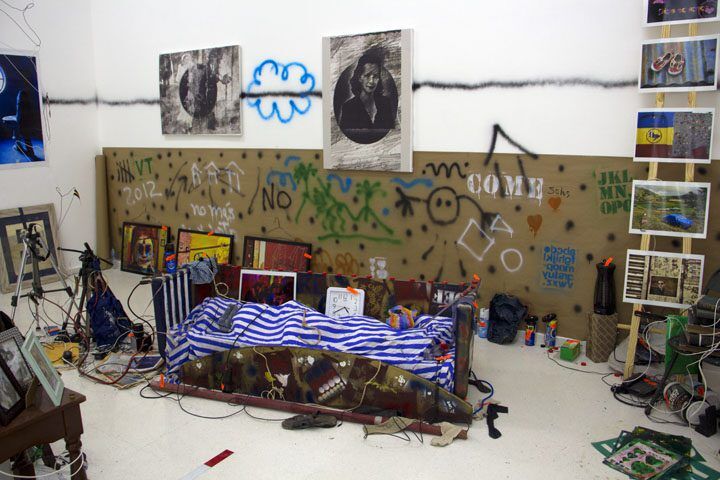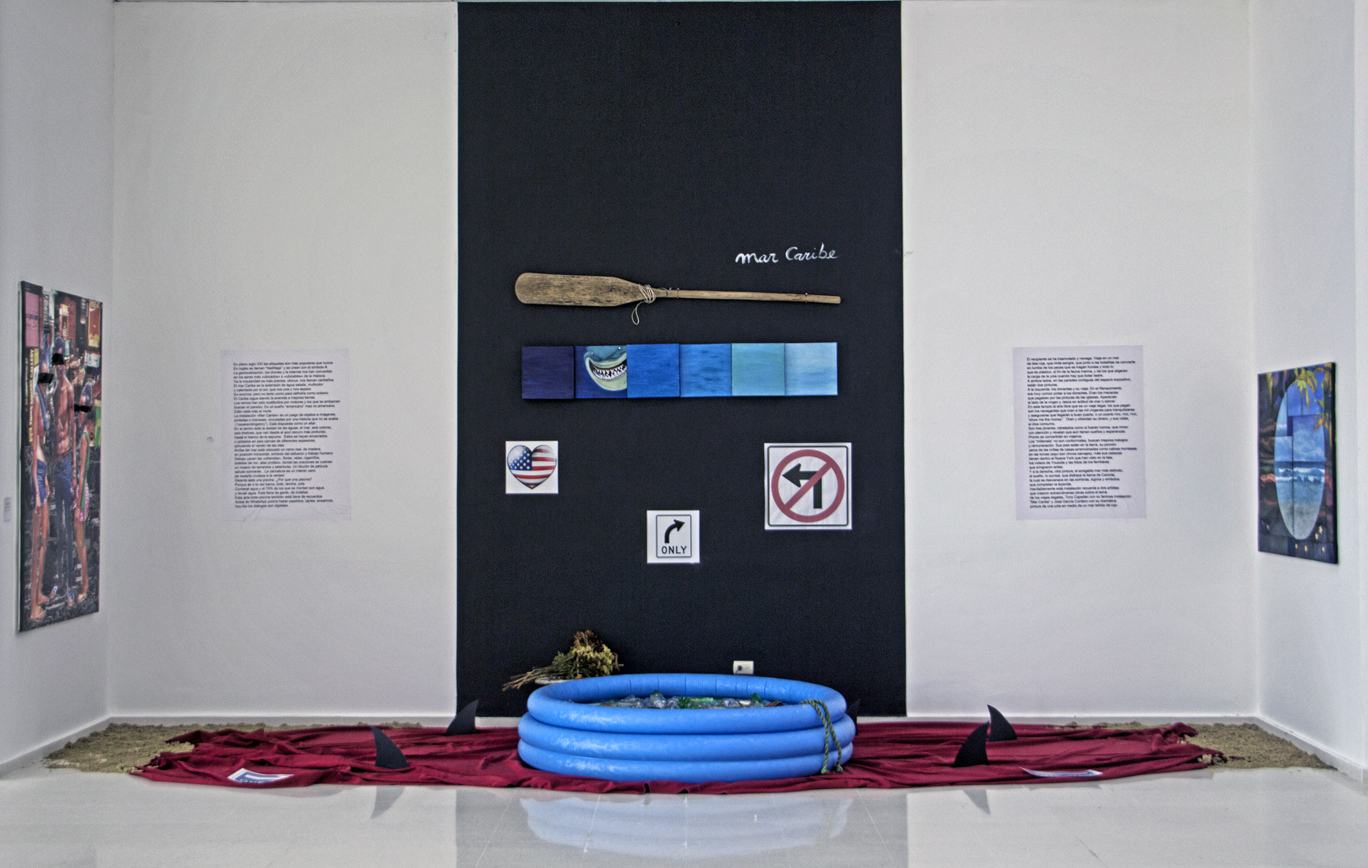
“Accumulations of Memory. Hyperconnected Chaos.” Partial view of the installation. Modern Art Museum.

“Caribbean Sea (Uelcon tu Paradais)
I will ” wow ” you when I get to land. Have faith. We will arrive, wait for my message.” Installation. Enriquillo Amiama. Modern Art Museum.
Concept
“Accumulations of Memory” is an architectural environment recreated based on autobiographical elements that, unlike Tracey Emin, does not show a real habitat but a fictional one. It presents an everyday environment of an imaginary artist in the midst of an economic and mental crisis that has led him to accumulate objects from distant memories and his day-to-day life.
The conceptual basting process began in 2012. And continued until 2020. Originally it was going to be until 2018, but the Biennial was postponed indefinitely.
The crisis that in those years was generated in the artistic environment made close art galleries, bookstores, and many artists were abandoned.
Economic growth did not go according to the pockets of the majority.
The memories are piling up. They are not found objects, they are bought and consumed. The brands stand out in a blatantly pop way.
I was working since 2010 on a specific topic, Facebook and its influence on our lives. The installation Accumulations of Memory is a kind of summary of what happens on the walls of this social network, where our memories are being printed. Then the process turned to Instagram (part of Facebook since 2012) because it was primarily visual.
The interaction of the public, friends, family, in these social networks, exponentially increases the accumulation of memories or memories.
The inspiration came from observing the actual accumulation process of an insane lord who lived under a dry bridge. He had various objects and many full and closed covers. He slept around what would be garbage to us and what he apparently held valuable his treasure.
As in many novels, I started from autobiographical elements to recreate fiction. Instead of a beggar, the architectural space would be inhabited by a photographer obsessed with his past and worried about his present economic crisis.
I worked on the installation as if it were a painting, seeking unity within variety as Plato postulated. The elements used to achieve it are color, harmonies, and contrasts. Then there are the rectangular shapes and lines.
The set could be divided into several small facilities, each one with its own independent, autonomous message, although all connected by a non-neural network, but with cables that simulate the synapses of the brain. All belong to memories, some of the short memory and others of the distant past, even from the time of tyranny, lost among centenary furniture from the early twentieth century.
There is a game of juxtapositions, contrasts that border on the absurd, and discordant analogies, a hyperconnected and “organized” chaos through a network, an electrical connection that unifies everything and returns the precarious unity.
All a consumer paraphernalia.
The central message of this multi installation is simple:
WE CANNOT FORGET
If this sounds political, it is not accidental.
E.A.
“The Caribbean Sea”. In the 21st century, labels are more popular than ever. In English, they are called “hashtags” and are created with the symbol #. Geolocation, drones, and the internet have made us the most “located” or “locatable” beings in history.
Insularity is more precise, ubiquitous, they call us Caribbean. The Caribbean Sea is the extension of salty, multicolored water heated by the sun, which unites us and separates us. It’s huge; but not enough to define it as an ocean.
The Caribbean continues to be the avenue to better lands. The oars have been replaced by motors and those who embark seek paradise. It is an “American” dream but not an American one. Eden is further north.
The installation «Mar Caribe» is a game of objects and images, painted or printed, linked by a story that never ends (“neverendingstory”). It is arranged like an altar. In the center is the deity of the waters, the sea, six colors, six shades, ranging from the deepest dark blue to the white of the foam. These have been enclosed or painted on six canvases of different thicknesses, simulating the swaying of the waves.
Above the sea is a real wooden oar, in a horizontal position, a symbol of human effort and work. Underneath lie the “offerings”, flowers, candles, cigarettes, bottles of rum, a profane altar, where prayers become a rosary of laments and death rattles. A movie shark greets smiling … The cartoon is a vain attempt to detract from the truth.
In front is a swimming pool. Why a swimming pool? Because it is at the same time a boat, boat, boat, yola. It contains water and 70% of those that are assembled are water, and they carry water. It is full of people, of bottles. This yola-boat-pool is also full of memories. Before WhatsApp there could be little pieces of paper, letters, spells; today the dialogues are digital.
The vessel has been transmuted and is sailing. Travel in a sea of red cloth, which imitates blood, which together with the little bottles becomes a tomb for the fish that swallow covers and everything that is plastic, the end of the marine fauna, and of those that lighten the load of the yola when it is necessary to throw ballast.
On both sides, on the adjoining walls of the exhibition space, are two paintings.
On the left: the donors and their journey. In the Renaissance, it was very common to paint donors. They were the patrons who paid for the paintings in the churches. They appeared next to the virgin and Jesus in an attitude of praying or adoration. In this open-air temple that is an illegal trip, those who pay are the sailors who pray to the thousand virgins to calm down and make sure that they will reach a good port, or a rich, rich, rich port, “show me the money.” They pray and offer their money, and their lives, to the consuming god.
They are three young people, portrayed as if they were icons, who look closely and reveal that they still have dreams and hopes. They will soon become travelers.
Millennials are not conformists, they seek better jobs and pay. Their feet are on the ground, their portion near the edges of houses swirling like mountain goats in the hills (here they are wild goats), plus their heads have inside the New York that they have seen on TV, YouTube videos, and photos of relatives who emigrated before.
And to the right, another painting, the more defined friendly sea, the dream, the surreal, that disguises the boat of Charon, which vanishes into the shadows, signs, and symbols that complete the legend.
Inevitably this installation recalls two artists who created extraordinary works on the theme of illegal travel, Tony Capellán with his famous installation “Mar Caribe” and José García Cordero with his dramatic painting of a boat in the middle of a sea dyed red.
